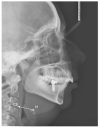Mandibular Torus as a New Index of Success for Mandibular Advancement Devices
- PMID: 36361031
- PMCID: PMC9657412
- DOI: 10.3390/ijerph192114154
Mandibular Torus as a New Index of Success for Mandibular Advancement Devices
Abstract
Background: In obstructive sleep apnoea (OSA), treatment with mandibular advancement devices (MADs) reduces patients' Apnoea-Hypopnoea index (AHI) scores and improves their sleepiness and quality of life. MADs are non-invasive alternatives for patients who cannot tolerate traditional continuous positive airway pressure (CPAP) therapy. The variability of responses to these devices makes it necessary to search for predictors of success. The aim of our study was to evaluate the presence of mandibular torus as a predictor of MAD efficacy in OSA and to identify other potential cephalometric factors that could influence the response to treatment.
Methods: This was a retrospective cohort study. The study included 103 patients diagnosed of OSA who met the criteria for initiation of treatment with MAD. Structural variables were collected (cephalometric and the presence or absence of mandibular torus). Statistical analysis was performed to evaluate the existence of predictive factors for the efficacy of MADs.
Results: A total of 103 patients who were consecutively referred for treatment with MAD were included (89.3% men); the mean age of the participants was 46.3 years, and the mean AHI before MAD was 31.4 (SD 16.2) and post- MAD 11.3 (SD 9.2). Thirty-three percent of patients had mandibular torus. Torus was associated with a better response (odds ratio (OR) = 2.854 (p = 0.035)) after adjustment for sex, age, body mass index (BMI; kg/m2), the angle formed by the occlusal plane to the sella-nasion plane (OCC plane to SN), overinjection, and smoking. No cephalometric predictors of efficacy were found that were predictive of MAD treatment success.
Conclusions: The presence of a mandibular torus practically triples the probability of MAD success. This is the simplest examination with the greatest benefits in terms of the efficacy of MAD treatment for OSA.
Keywords: cephalometry; mandibular advancement devices; mandibular torus; obstructive sleep apnoea.
Conflict of interest statement
The authors declare no conflict of interest.
Figures





References
-
- Cobo J., Canut J.A., Carlos F., Vijande M., Llamas J.M. Changes in the upper airway of patients who wear a modified functional appliance to treat obstructive sleep apnea. Int. J. Adult Orthodon. Orthognath. Surg. 1995;10:53–57. - PubMed
MeSH terms
LinkOut - more resources
Full Text Sources
Miscellaneous

